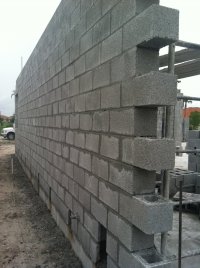-
Welcome to The Building Code Forum
Your premier resource for building code knowledge.
This forum remains free to the public thanks to the generous support of our Sawhorse Members and Corporate Sponsors. Their contributions help keep this community thriving and accessible.
Want enhanced access to expert discussions and exclusive features? Learn more about the benefits here.
Ready to upgrade? Log in and upgrade now.
You are using an out of date browser. It may not display this or other websites correctly.
You should upgrade or use an alternative browser.
You should upgrade or use an alternative browser.
Why you bring a hammer to a CMU inspection
- Thread starter jar546
- Start date
I can only imagine the trouble that I would be in if I punched holes in CMU.
I was a carpenter working for an alcoholic superintendent. We were remodeling a Payless drug store. There was a mostly glass wall between the garden dept. and the store. It came time to demo the wall. The drunk took a 20 oz. hammer and threw it at an 8’ x 8’ glass pane. The hammer ricocheted off the glass, shot into the camera dept. and smashed a boom box.
The stores were identical. I was the superintendent on the next store. I saved the glass from that store and a few more. The plan was to enclose my swimming pool. I never got around to it and the glass was used for a greenhouse instead. I made a rack to haul the glass from the lumber that was used to build a security catwalk. The catwalk was made from scaffold plank material.
I was a carpenter working for an alcoholic superintendent. We were remodeling a Payless drug store. There was a mostly glass wall between the garden dept. and the store. It came time to demo the wall. The drunk took a 20 oz. hammer and threw it at an 8’ x 8’ glass pane. The hammer ricocheted off the glass, shot into the camera dept. and smashed a boom box.
The stores were identical. I was the superintendent on the next store. I saved the glass from that store and a few more. The plan was to enclose my swimming pool. I never got around to it and the glass was used for a greenhouse instead. I made a rack to haul the glass from the lumber that was used to build a security catwalk. The catwalk was made from scaffold plank material.
jar546
CBO
It would be doing your job.I can only imagine the trouble that I would be in if I punched holes in CMU.
Yikes
SAWHORSE
Not trying to downplay the omission of grout, but I don't understand several things that led to "hammer time":
1. Does your jurisdiction require deputy inspections during grouting?
2. Did it appear solid grouted when looking down from above, such that only smashing the block would reveal the void? Or was the void also visible from above?
3. Hammering the block seems like a destructive testing / last resort for verification. Were there other clues that first led you to be suspicious the cels weren't grouted? Or is this standard practice for grout inspection? (Not trying to be critical, but trying to understand here.)

1. Does your jurisdiction require deputy inspections during grouting?
2. Did it appear solid grouted when looking down from above, such that only smashing the block would reveal the void? Or was the void also visible from above?
3. Hammering the block seems like a destructive testing / last resort for verification. Were there other clues that first led you to be suspicious the cels weren't grouted? Or is this standard practice for grout inspection? (Not trying to be critical, but trying to understand here.)

I use a tuning fork.It would be doing your job.
jar546
CBO
1) I don't know what deputy inspections means.
2) I don't know, I arrived after the fact.
3) If it was grouted as required by the plans, it would not be destructive. This is standard practice to make sure they did not block the cells to save concrete.
Apparently the inspection paid off. Normally the bottom block are chipped out, inspected for rebar, then covered with plywood and then removed after the concrete is poured. Normally you don't find this stuff unless inspection holes are missing or were missed during the pre-fill cell inspection.
2) I don't know, I arrived after the fact.
3) If it was grouted as required by the plans, it would not be destructive. This is standard practice to make sure they did not block the cells to save concrete.
Apparently the inspection paid off. Normally the bottom block are chipped out, inspected for rebar, then covered with plywood and then removed after the concrete is poured. Normally you don't find this stuff unless inspection holes are missing or were missed during the pre-fill cell inspection.
jar546
CBO
Here are some examples. I've posted pics like this before. Click on the pics to enlarge.Not trying to downplay the omission of grout, but I don't understand several things that led to "hammer time":
1. Does your jurisdiction require deputy inspections during grouting?
2. Did it appear solid grouted when looking down from above, such that only smashing the block would reveal the void? Or was the void also visible from above?
3. Hammering the block seems like a destructive testing / last resort for verification. Were there other clues that first led you to be suspicious the cels weren't grouted? Or is this standard practice for grout inspection? (Not trying to be critical, but trying to understand here.)



CMU construction is common in Florida and not so much in So. California. So it makes sense that you have stringent inspection techniques. Tapping the face shell with a hammer might tell you if the cell has grout. We have a special inspectors performing inspections during masonry construction. It might be periodic inspections.
steveray
SAWHORSE
And it MIGHT actually be inspected....We have a special inspectors performing inspections during masonry construction. It might be periodic inspections.
MtnArch
SAWHORSE
And in Cali ALL cells are normally called out to be grouted solid - not just bond beams and certain verticals.
Another name for special inspectors... usually originating from California, particularly the LA area in my experience.1) I don't know what deputy inspections means.
From LA DBS - Deputy Inspectors provide a service to builders who require continuous inspection for time periods that Building and Safety Inspectors cannot otherwise fulfill. Deputy Inspectors can be certified in multiple areas. Building and Safety certifies Deputy Inspectors through a rigorous examination and interview process. LADBS continually evaluates the work performed by the Registered Deputy Inspectors to maintain a high standard of excellence. It is important to acquire the services of a Deputy Inspector with the correct certifications. Otherwise, approval for the related work may not be approved by Building and Safety.
jar546
CBO
Yes, and how is that verified?And in Cali ALL cells are normally called out to be grouted solid - not just bond beams and certain verticals.
Yikes
SAWHORSE
1) I don't know what deputy inspections means.
2) I don't know, I arrived after the fact.
3) If it was grouted as required by the plans, it would not be destructive. This is standard practice to make sure they did not block the cells to save concrete.
Apparently the inspection paid off. Normally the bottom block are chipped out, inspected for rebar, then covered with plywood and then removed after the concrete is poured. Normally you don't find this stuff unless inspection holes are missing or were missed during the pre-fill cell inspection.
OK, so on this kind of project, the CMU is not the finish surface of the wall; it will get covered with some other finish in the future; thus, hitting it with a hammer for purposes of inspection has no detrimental effect on the finish surface of the wall.
Is this correct?
Yikes
SAWHORSE
https://www.ladbs.org/docs/default-...pection-ib-p-bc2011-035.pdf?sfvrsn=198eb53_52Yes, and how is that verified?
Pounding on the wall with a hammer is apparently an accepted practice in Jeff's jurisdiction. If that were done anywhere that I have worked, there would be a valid complaint. If I had a reason to suspect that the cells were not filled, I would resort to a 1/4" drill bit and even that would raise eyebrows.OK, so on this kind of project, the CMU is not the finish surface of the wall; it will get covered with some other finish in the future; thus, hitting it with a hammer for purposes of inspection has no detrimental effect on the finish surface of the wall.
Is this correct?
mtlogcabin
SAWHORSE
You do not have to hit the block hard enough to knock a hole in the CMU to determine if it is hollow or not, just tapping on it you can tell if it is solid filled cell or not. 15 years of knocking holes in new and existing CMU walls in South Florida, it's not rocket science.
Yikes
SAWHORSE
Pounding on the wall with a hammer is apparently an accepted practice in Jeff's jurisdiction. If that were done anywhere that I have worked, there would be a valid complaint. If I had a reason to suspect that the cells were not filled, I would resort to a 1/4" drill bit and even that would raise eyebrows.
Again, out here in California it would be straightforward, as our structural plans for CMU would include at least these 3 notes (along with others) for grouting:

If a contractor claimed to have grouted walls without the required deputy inspection, as a default they would theoretically have to tear it out and start over. This of course would freak them out, and they would seek to pay for other methods of grout verification in lieu of demolition, including any/all of the following:
- Non-intrusive:
- X-ray
- Ultrasound
- Pachometer
- Intrusive:
- Random core samples
- Hammer time
Note that even if a hammer revealed the presence of grout, without core samples tests for design strength the structural engineer might not grant final signoff.
Attachments
Yankee Chronicler
REGISTERED
IBC 2021, Chapter 17, Special Inspections:
1705.4 Masonry construction. Special inspections and tests
of masonry construction shall be performed in accordance
with the quality assurance program requirements of TMS
402 and TMS 602.
Exception: Special inspections and tests shall not be
required for:
1. Empirically designed masonry, glass unit
masonry or masonry veneer designed in accordance
with Section 2109, Section 2110 or Chapter
14, respectively, where they are part of a structure
classified as Risk Category I, II or III.
2. Masonry foundation walls constructed in accordance
with Table 1807.1.6.3(1), 1807.1.6.3(2),
1807.1.6.3(3) or 1807.1.6.3(4).
3. Masonry fireplaces, masonry heaters or masonry
chimneys installed or constructed in accordance
with Section 2111, 2112 or 2113, respectively.
1705.4 Masonry construction. Special inspections and tests
of masonry construction shall be performed in accordance
with the quality assurance program requirements of TMS
402 and TMS 602.
Exception: Special inspections and tests shall not be
required for:
1. Empirically designed masonry, glass unit
masonry or masonry veneer designed in accordance
with Section 2109, Section 2110 or Chapter
14, respectively, where they are part of a structure
classified as Risk Category I, II or III.
2. Masonry foundation walls constructed in accordance
with Table 1807.1.6.3(1), 1807.1.6.3(2),
1807.1.6.3(3) or 1807.1.6.3(4).
3. Masonry fireplaces, masonry heaters or masonry
chimneys installed or constructed in accordance
with Section 2111, 2112 or 2113, respectively.


